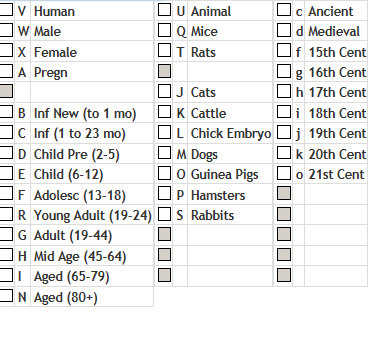Check Tags
Introduction
Virtually every biomedical article will describe subjects of research (human or animal; mice or rats, etc). Clinical articles will describe treatment, diagnosis, etc of diseases in patients. These articles will almost always mention the number of patients, their gender and age. Experimental articles will almost always mention the species and gender of the animal. HUMAN and ANIMAL are the most widely used searching terms in PubMed.
These concepts which are mentioned in almost every article (human, animal, male, female, child, etc) are designated Check Tags. In the past, when MeSH indexers had to type MeSH terms, data forms were preprinted with these frequently occurring concepts, and indexers simply checked the appropriate box.
Check tags are routinely added to the indexing even if just mentioned in the article. The check tag concept does not need to be discussed. For example if an article only mentions that the subject of the study was a pregnant 35 year old, the indexer must check the tags PREGNANCY, HUMAN, FEMALE and ADULT. Check tag concepts may be found anywhere in the article - in the Materials and Methods section of the article, in tables, in the text associated with a figure, etc.
Below is the list of Check Tags:

Last Reviewed: January 24, 2017

